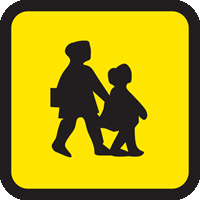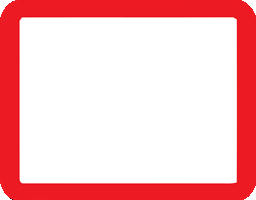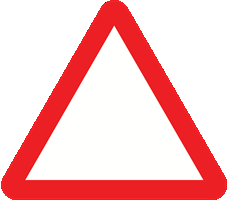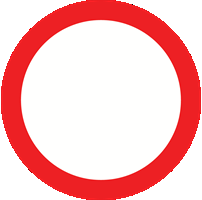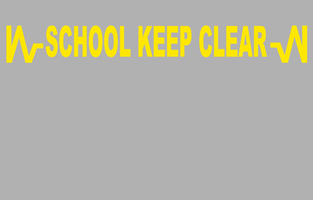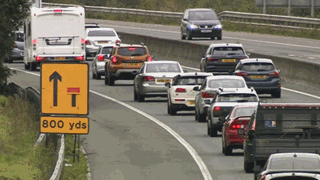This mock driving theory test consists of 50 official questions.
You need 43 out of 50 (86%) to pass. You have a time limit of 57 minutes.
Read more about the theory test and how it works.
There are no tests related to this category :
There are no tests related to this category :
Quick view of test questions. Click question box to reveal correct answer.
Correct Answer: D
Explanation: Prior to overtaking, consider if it’s really needed. If you can’t see far enough, keep back and wait for a better place to pull out.
Explanation: Prior to overtaking, consider if it’s really needed. If you can’t see far enough, keep back and wait for a better place to pull out.
A
B
C
D
B
C
D
Correct Answer: C
Explanation: Pull over to the side of the road so that the ambulance can safely pass. Make sure there aren't any bollards or other hazards in the road that would hinder the ambulance’s progress.
Explanation: Pull over to the side of the road so that the ambulance can safely pass. Make sure there aren't any bollards or other hazards in the road that would hinder the ambulance’s progress.
Correct Answer: A
Explanation: A vehicle with a green flashing beacon indicates that the driver or passenger is a doctor on call. If it's safe to do so, give way to the vehicle. Keep in mind that the vehicle may be travelling at speed or may make a sudden stop.
Explanation: A vehicle with a green flashing beacon indicates that the driver or passenger is a doctor on call. If it's safe to do so, give way to the vehicle. Keep in mind that the vehicle may be travelling at speed or may make a sudden stop.
Correct Answer: A
Explanation: To prevent braking and steering problems from developing, you should ensure your tyres are free from defects. They should be sufficiently inflated and have optimum tread depth and tyre pressure. This provides for a safer, more comfortable driving experience as well as reducing the risk of skidding.
Explanation: To prevent braking and steering problems from developing, you should ensure your tyres are free from defects. They should be sufficiently inflated and have optimum tread depth and tyre pressure. This provides for a safer, more comfortable driving experience as well as reducing the risk of skidding.
5. As you approach this bridge, which type of vehicle should you be ready to give way to?
Mark one answer

B
C
D
Correct Answer: A
Explanation: High-sided vehicles (lorries, buses etc.) will need to move to the centre of the road to pass safely beneath the bridge. Signs normally indicate bridges where this has to happen. Look through the bridge to see what's coming, and be prepared to stop to give way if necessary.
Explanation: High-sided vehicles (lorries, buses etc.) will need to move to the centre of the road to pass safely beneath the bridge. Signs normally indicate bridges where this has to happen. Look through the bridge to see what's coming, and be prepared to stop to give way if necessary.
Correct Answer: C
Explanation: You'll see this sign on the backs of school buses and coaches. These vehicles carry children and are often seen on the roads at busy times. Expect vehicles showing this sign to make frequent stops, and be aware that it might stop to collect or drop off passengers at places that aren't normal bus stops.
Explanation: You'll see this sign on the backs of school buses and coaches. These vehicles carry children and are often seen on the roads at busy times. Expect vehicles showing this sign to make frequent stops, and be aware that it might stop to collect or drop off passengers at places that aren't normal bus stops.
7. At a roundabout, which of these vehicles is most likely to take an unusual course?
Mark one answer
AB
C
D
Correct Answer: B
Explanation: Due to their length, lorries and HGVs might need to take unusual courses around roundabouts to avoid mounting the centre of the roundabout. Be aware of this, and allow them plenty of space.
Explanation: Due to their length, lorries and HGVs might need to take unusual courses around roundabouts to avoid mounting the centre of the roundabout. Be aware of this, and allow them plenty of space.
Correct Answer: D
Explanation: Traffic signs that give orders are circular, and a red border means they're prohibitive. Eight-sided 'stop' signs also give orders, and are one of the few exceptions to this. It is compulsory to comply with orders given on these signs.
Explanation: Traffic signs that give orders are circular, and a red border means they're prohibitive. Eight-sided 'stop' signs also give orders, and are one of the few exceptions to this. It is compulsory to comply with orders given on these signs.
Correct Answer: D
Explanation: This sign indicates that the road is only for use by trams. As trams cannot leave their rails to manoeuvre around obstacles, you should never block tram routes. Take extra care in systems allowing motor vehicles and trams, as trams are quick and quiet, and could appear unexpectedly.
Explanation: This sign indicates that the road is only for use by trams. As trams cannot leave their rails to manoeuvre around obstacles, you should never block tram routes. Take extra care in systems allowing motor vehicles and trams, as trams are quick and quiet, and could appear unexpectedly.

B
C
D
Correct Answer: D
Explanation: An amber traffic light tells you to stop and wait behind the line. You should then wait for the duration of the red light. You should only through an amber light if you've already crossed the line, or if stopping could cause a collision.
Explanation: An amber traffic light tells you to stop and wait behind the line. You should then wait for the duration of the red light. You should only through an amber light if you've already crossed the line, or if stopping could cause a collision.
11. You're approaching this junction. You see a 'stop' sign accompanied by a solid white line on the road. Why are you being instructed to stop?
Mark one answer
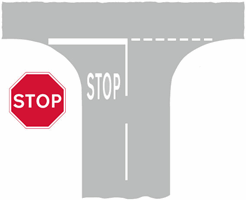
B
C
D
Correct Answer: D
Explanation: The solid white line tells you to stop. This instruction is given because the view onto the main road is restricted. You might also see a stop sign. Don't pull out until you're sure it is safe to do so.
Explanation: The solid white line tells you to stop. This instruction is given because the view onto the main road is restricted. You might also see a stop sign. Don't pull out until you're sure it is safe to do so.
Correct Answer: C
Explanation: Toucan crossings allow both cyclists and pedestrians to cross simultaneously. Cyclists may approach the crossing at high speeds, so be extra wary of this.
Explanation: Toucan crossings allow both cyclists and pedestrians to cross simultaneously. Cyclists may approach the crossing at high speeds, so be extra wary of this.
13. What should you do if you see flashing amber lights beneath a school warning sign?
Mark one answer
AB
C
D
Correct Answer: C
Explanation: The flashing amber lights are there to warn you of children crossing nearby (usually close to a school). Take extra care and keep your speed low in case you need to stop.
Explanation: The flashing amber lights are there to warn you of children crossing nearby (usually close to a school). Take extra care and keep your speed low in case you need to stop.
Correct Answer: C
Explanation: Taking a 15-minute break every two hours is the recommended balance, and it's suggested you plan a trip with this in mind. Doing so will help you stay focused on driving safely.
Explanation: Taking a 15-minute break every two hours is the recommended balance, and it's suggested you plan a trip with this in mind. Doing so will help you stay focused on driving safely.
15. What colour are the reflective studs on the left-hand lane of the carriageway on a motorway?
Mark one answer
AB
C
D
Correct Answer: C
Explanation: Different coloured reflective studs are fixed to the road at the edges of motorways and between lanes. Red studs mark the boundary between the hard shoulder and the edge of the carriageway. Use reflective studs to identify which lane you're in in the dark.
Explanation: Different coloured reflective studs are fixed to the road at the edges of motorways and between lanes. Red studs mark the boundary between the hard shoulder and the edge of the carriageway. Use reflective studs to identify which lane you're in in the dark.
Correct Answer: B
Explanation: The right-hand lane on a dual carriageway should be used for overtaking or turning right. Under most circumstances, you should stay in the left lane. Move back to the left after overtaking, but ensure you leave a safe gap between you and the vehicle you've overtaken.
Explanation: The right-hand lane on a dual carriageway should be used for overtaking or turning right. Under most circumstances, you should stay in the left lane. Move back to the left after overtaking, but ensure you leave a safe gap between you and the vehicle you've overtaken.
Correct Answer: D
Explanation: Driving with under-inflated tyres will worsen fuel consumption. Check your tyre pressures once per week. Low-pressure tyres have higher 'rolling resistance,' making the engine work harder.
Explanation: Driving with under-inflated tyres will worsen fuel consumption. Check your tyre pressures once per week. Low-pressure tyres have higher 'rolling resistance,' making the engine work harder.
Correct Answer: D
Explanation: These markings are intended to keep the area around school crossings clear. They shouldn't be parked at even if you're just intending to pick up or drop off children. Keeping this area clear ensures nearby drivers have a good view of the crossing, and ensures people near the crossing have a good view of the road.
Explanation: These markings are intended to keep the area around school crossings clear. They shouldn't be parked at even if you're just intending to pick up or drop off children. Keeping this area clear ensures nearby drivers have a good view of the crossing, and ensures people near the crossing have a good view of the road.
19. You come across a two-way road divided into three lanes. Why should you take extra care here?
Mark one answer
AB
C
D
Correct Answer: D
Explanation: The centre lane can be used for overtaking by traffic travelling in either direction, so it's possible oncoming traffic could plan to overtake at the same time you do. Ensure you indicate early and have thoroughly scanned the road ahead before pulling out.
Explanation: The centre lane can be used for overtaking by traffic travelling in either direction, so it's possible oncoming traffic could plan to overtake at the same time you do. Ensure you indicate early and have thoroughly scanned the road ahead before pulling out.
Correct Answer: C
Explanation: A solid red light will be shown following amber at traffic lights. You should stop provided doing so won't cause a collision, and provided you haven't already passed the white line. Only proceed again when the lights turn green and your exit is clear. Be aware as you approach traffic lights that have been green for a while that they could change soon. Be prepared to slow down and stop if amber appears.
Explanation: A solid red light will be shown following amber at traffic lights. You should stop provided doing so won't cause a collision, and provided you haven't already passed the white line. Only proceed again when the lights turn green and your exit is clear. Be aware as you approach traffic lights that have been green for a while that they could change soon. Be prepared to slow down and stop if amber appears.

B
C
D
Correct Answer: D
Explanation: You should not continue until the lights turn green and your exit is clear. Traffic from other directions might still be clearing the junction while the lights are on red and amber.
Explanation: You should not continue until the lights turn green and your exit is clear. Traffic from other directions might still be clearing the junction while the lights are on red and amber.
Correct Answer: A
Explanation: Emergency refuge areas are areas at the side of the motorway that provide shelter and an emergency telephone that connects directly to a control centre. If you pulled over for an emergency but that emergency has now passed, take care re-joining the motorway, especially if the hard shoulder is being used as a normal lane.
Explanation: Emergency refuge areas are areas at the side of the motorway that provide shelter and an emergency telephone that connects directly to a control centre. If you pulled over for an emergency but that emergency has now passed, take care re-joining the motorway, especially if the hard shoulder is being used as a normal lane.
Correct Answer: D
Explanation: Traffic officers are allowed to stop and direct traffic on motorways and some 'A' class roads, even though they don't have enforcement powers. Traffic officers work in partnership with police at incidents. They can be recognised by their orange-and-yellow reflective jackets and the yellow-and-black markings on their vehicles.
Explanation: Traffic officers are allowed to stop and direct traffic on motorways and some 'A' class roads, even though they don't have enforcement powers. Traffic officers work in partnership with police at incidents. They can be recognised by their orange-and-yellow reflective jackets and the yellow-and-black markings on their vehicles.
24. You are driving behind a lorry on the motorway. A large box falls from the vehicle onto the road. How should you react?
Mark one answer
AB
C
D
Correct Answer: A
Explanation: Given the size of their vehicles, it's not uncommon for lorry drivers to miss seeing objects falling from their vehicles. If the driver doesn't stop following this happening, don't attempt to rescue the object. Instead, stop safely on the hard shoulder and report the hazard on an emergency telephone.
Explanation: Given the size of their vehicles, it's not uncommon for lorry drivers to miss seeing objects falling from their vehicles. If the driver doesn't stop following this happening, don't attempt to rescue the object. Instead, stop safely on the hard shoulder and report the hazard on an emergency telephone.
Correct Answer: C
Explanation: Both red and amber lights will show following a red traffic light. As you approach lights, you should always be aware of the next signal to come, and prepare accordingly to prevent late braking or hesitation.
Explanation: Both red and amber lights will show following a red traffic light. As you approach lights, you should always be aware of the next signal to come, and prepare accordingly to prevent late braking or hesitation.
26. In which circumstances should a motorcyclist's helmet be removed following a crash?
Mark one answer
AB
C
D
Correct Answer: C
Explanation: You should not remove a motorcyclist's helmet unless it is absolutely necessary. Doing so could cause further injury, and they may be suffering from shock. Reassure them with confidence that they will be okay, but don’t let them eat.
Explanation: You should not remove a motorcyclist's helmet unless it is absolutely necessary. Doing so could cause further injury, and they may be suffering from shock. Reassure them with confidence that they will be okay, but don’t let them eat.
A
B
C
D
B
C
D
Correct Answer: D
Explanation: Warning other traffic should be your first priority, ensuring there is no risk of further collision. Turn on your hazard warning lights to warn other drivers, and ensure all engines are turned off to reduce risk of fire. The motorcyclists is in a very vulnerable position, and you should ensure that in helping them you don't put yourself or others at risk.
Explanation: Warning other traffic should be your first priority, ensuring there is no risk of further collision. Turn on your hazard warning lights to warn other drivers, and ensure all engines are turned off to reduce risk of fire. The motorcyclists is in a very vulnerable position, and you should ensure that in helping them you don't put yourself or others at risk.
A
B
C
D
B
C
D
Correct Answer: D
Explanation: Raising the leg above heart level will reduce the flow of blood to the limb, and therefore reduce blood loss. Provided there is no debris in the wound, blood loss can be slowed further with a bandage or clean cloth. Tying something around the leg to reduce blood flow is not advised, as it can lead to permanent damage.
Explanation: Raising the leg above heart level will reduce the flow of blood to the limb, and therefore reduce blood loss. Provided there is no debris in the wound, blood loss can be slowed further with a bandage or clean cloth. Tying something around the leg to reduce blood flow is not advised, as it can lead to permanent damage.
29. As a recently qualified driver, how could you reduce your chances of being involved in an accident?
Mark one answer
AB
C
D
Correct Answer: A
Explanation: Completing a Pass Plus course will help you get used to driving in different conditions. Newly qualified drivers and riders are more likely than experienced drivers to be involved in a collision due to lack of experience. Completing an additional training course can help improve reactions to hazards.
Explanation: Completing a Pass Plus course will help you get used to driving in different conditions. Newly qualified drivers and riders are more likely than experienced drivers to be involved in a collision due to lack of experience. Completing an additional training course can help improve reactions to hazards.
A
B
C
D
B
C
D
Correct Answer: B
Explanation: Fresh air can help keep you alert when you begin to feel tired, but your first priority should always be using the next service area or motorway exit to find a safe place to rest.
Explanation: Fresh air can help keep you alert when you begin to feel tired, but your first priority should always be using the next service area or motorway exit to find a safe place to rest.
Correct Answer: C
Explanation: To see if your vehicle is safe to drive, consult your vehicle handbook or phone a local garage. You should only drive to the garage if you're sure it's safe, and should call out an expert if you're in doubt.
Explanation: To see if your vehicle is safe to drive, consult your vehicle handbook or phone a local garage. You should only drive to the garage if you're sure it's safe, and should call out an expert if you're in doubt.
Correct Answer: B
Explanation: Wearing sensible, flat shoes will give you better control over the pedals. In general, you should wear comfortable clothes while driving.
Explanation: Wearing sensible, flat shoes will give you better control over the pedals. In general, you should wear comfortable clothes while driving.
Correct Answer: C
Explanation: Traffic in the right lane will merge into the left. Be patient and courteous, and allow this to happen.
Explanation: Traffic in the right lane will merge into the left. Be patient and courteous, and allow this to happen.
34. What should you do if you're stopped at a pelican crossing and the lights turn green while a disabled person is crossing?
Mark one answer
AB
C
D
Correct Answer: D
Explanation: You should let them finish before you continue. The green light at a pelican crossing means you can continue if the crossing is clear, so if someone is still crossing, be patient and allow them to finish before you go.
Explanation: You should let them finish before you continue. The green light at a pelican crossing means you can continue if the crossing is clear, so if someone is still crossing, be patient and allow them to finish before you go.
Correct Answer: A
Explanation: Any pedestrians attempting to cross the road past the bus will only become visible as they step onto the road. Be aware of this and keep your speed low. Additionally, watch for the bus signalling to pull away, and give way to it if it is safe to do so.
Explanation: Any pedestrians attempting to cross the road past the bus will only become visible as they step onto the road. Be aware of this and keep your speed low. Additionally, watch for the bus signalling to pull away, and give way to it if it is safe to do so.
Correct Answer: A
Explanation: Gentle braking and acceleration lead to improved fuel consumption, therefore reducing the impact of a vehicle on the environment. Harsh braking and acceleration cause increased vehicle wear and emissions. Regular vehicle servicing can help reduce both emissions and breakdowns.
Explanation: Gentle braking and acceleration lead to improved fuel consumption, therefore reducing the impact of a vehicle on the environment. Harsh braking and acceleration cause increased vehicle wear and emissions. Regular vehicle servicing can help reduce both emissions and breakdowns.
37. You've stalled on a level crossing and the engine won't restart. What should you do if the warning bells start to ring?
Mark one answer
AB
C
D
Correct Answer: B
Explanation: You and any passengers should remain calm. If the warning bells ring before you're able to restart your engine, you and your passengers should get well clear of the crossing on foot.
Explanation: You and any passengers should remain calm. If the warning bells ring before you're able to restart your engine, you and your passengers should get well clear of the crossing on foot.
A
B
C
D
B
C
D
Correct Answer: A
Explanation: You should check your exterior and interior mirrors to make sure the road is clear before moving off. Check your blind spots too, and be prepared to use arm signals if you feel other drivers might not understand your intentions.
Explanation: You should check your exterior and interior mirrors to make sure the road is clear before moving off. Check your blind spots too, and be prepared to use arm signals if you feel other drivers might not understand your intentions.
39. In icy conditions, what distance should you maintan from the vehicle in front of you?
Mark one answer
AB
C
D
Correct Answer: D
Explanation: In icy conditions, you should be ten times further from the vehicle in front than normal. Wherever possible, avoid driving in snowy weather, and remember that it will take much longer to stop. Be extra careful.
Explanation: In icy conditions, you should be ten times further from the vehicle in front than normal. Wherever possible, avoid driving in snowy weather, and remember that it will take much longer to stop. Be extra careful.
Correct Answer: A
Explanation: You should use your dipped headlights during the day when visibility is poor, and only turn on your fog lights if visibility is very poor. Using fog lights when conditions aren't poor can dazzle other drivers.
Explanation: You should use your dipped headlights during the day when visibility is poor, and only turn on your fog lights if visibility is very poor. Using fog lights when conditions aren't poor can dazzle other drivers.
Correct Answer: C
Explanation: Rear fog lights allow other drivers to see you more easily in foggy conditions. You shouldn't use the lights of the vehicle in front as a guide, as it may result in you driving too close to them or driving with a false sense of security.
Explanation: Rear fog lights allow other drivers to see you more easily in foggy conditions. You shouldn't use the lights of the vehicle in front as a guide, as it may result in you driving too close to them or driving with a false sense of security.
Correct Answer: B
Explanation: If you need to park away from home, using a secure car park will help deter thieves.
Explanation: If you need to park away from home, using a secure car park will help deter thieves.
Correct Answer: A
Explanation: An improperly secured filler cap can cause fuel to spill, usually at junctions, roundabouts, and on bends. Spilled fuel makes the road surface slippery. This is especially true during long periods of dry weather, when there's been no rain to wash away previous spills.
Explanation: An improperly secured filler cap can cause fuel to spill, usually at junctions, roundabouts, and on bends. Spilled fuel makes the road surface slippery. This is especially true during long periods of dry weather, when there's been no rain to wash away previous spills.
Correct Answer: A
Explanation: Thieves can be deterred from stealing your radio if they see that it's security-coded. Security-coded radios are of little use after being removed.
Explanation: Thieves can be deterred from stealing your radio if they see that it's security-coded. Security-coded radios are of little use after being removed.
Correct Answer: D
Explanation: Vehicle Watch Scheme stickers invite police to stop your vehicle if it's seen being used between midnight and 5am. Presence of the sticker in your car will deter thieves from stealing it, and increase the odds of the thief being caught if they do steal it.
Explanation: Vehicle Watch Scheme stickers invite police to stop your vehicle if it's seen being used between midnight and 5am. Presence of the sticker in your car will deter thieves from stealing it, and increase the odds of the thief being caught if they do steal it.
Correct Answer: C
Explanation: Anti-lock brakes are most effective when you're braking hard to stop quickly. You should keep your foot pressed firmly on the brake until you come to a stop. It's normal to hear a grating sound and feel vibration through the pedal as you press down.
Explanation: Anti-lock brakes are most effective when you're braking hard to stop quickly. You should keep your foot pressed firmly on the brake until you come to a stop. It's normal to hear a grating sound and feel vibration through the pedal as you press down.
47. You break down on the motorway and use your mobile to call for help. What should you do?
Mark one answer
AB
C
D
Correct Answer: D
Explanation: In ideal circumstances, you should use an emergency telephone following a motorway breakdown, because the operator will be able to pinpoint your location. If you can't do this, take note of the number on the nearest marker post, and supply this to the emergency services. This will enable them to reach you as soon as possible.
Explanation: In ideal circumstances, you should use an emergency telephone following a motorway breakdown, because the operator will be able to pinpoint your location. If you can't do this, take note of the number on the nearest marker post, and supply this to the emergency services. This will enable them to reach you as soon as possible.
Correct Answer: A
Explanation: You should park in well-lit areas at night whenever possible.
Explanation: You should park in well-lit areas at night whenever possible.
Correct Answer: D
Explanation: The Pass Plus scheme is designed for new drivers. It enhances basic skills and familiarises drivers with motorway driving and driving in different conditions, reducing the likelihood of a new driver being involved in an incident.
Explanation: The Pass Plus scheme is designed for new drivers. It enhances basic skills and familiarises drivers with motorway driving and driving in different conditions, reducing the likelihood of a new driver being involved in an incident.
50. What should you do if you're waiting at the side of the road to pick someone up, but know they might be a while?
Mark one answer
AB
C
D
Correct Answer: B
Explanation: You should turn off your engine if you're likely to remain stationary for a while. This reduces fuel consumption and exhaust emissions, reducing your vehicle's impact on the planet.
Explanation: You should turn off your engine if you're likely to remain stationary for a while. This reduces fuel consumption and exhaust emissions, reducing your vehicle's impact on the planet.


